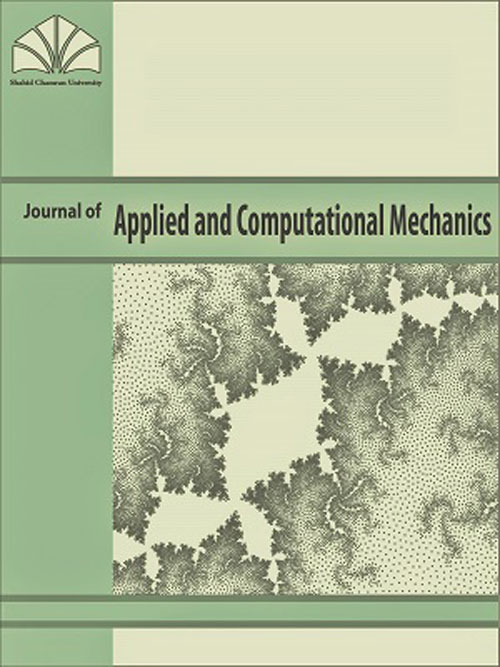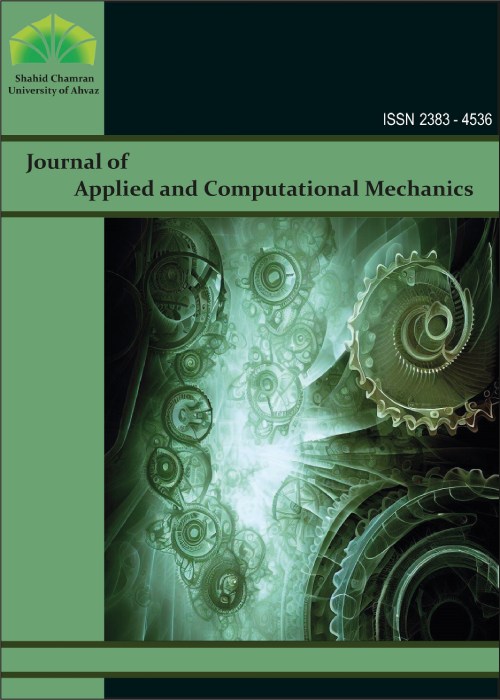فهرست مطالب

Journal of Applied and Computational Mechanics
Volume:1 Issue: 4, Autumn 2015
- تاریخ انتشار: 1394/09/30
- تعداد عناوین: 6
-
-
Pages 168-180The present research investigates the implementations of different computational geometry technologies in isogeometric analysis framework for computational fracture mechanics. NURBS and T-splines are two different computational geometry technologies which are studied in this work. Among the features of B-spline basis functions, the possibility of enhancing a B-spline basis with discontinuities by means of knot insertion makes isogeometric analysis method a suitable candidate for modeling discrete cracks. Also, the repetition of two different control points between two patches can create a discontinuity in and demonstrates a singularity in the stiffness matrix. In the case of a pre-defined interface, non-uniform rational B-splines are used to obtain an efficient discretization. T-splines constitute a type of computational geometry technology with the possibility of local refinement and with no topologically rectangular arrangement of control points. Therefore, T-splines can decrease superfluous control points which do not have any major effects on the geometry. Various numerical simulations demonstrate the suitability of the isogeometric approach in fracture mechanics.Keywords: Fracture mechanics, Isogeometric analysis method, Knot insertion, NURBS, T, spline
-
Pages 181-186This study introduces the Differential Transform Method (DTM) in the analysis of the free vibration response of a rotating closed section composite, Timoshenko beam, which features material coupling between flapwise bending and torsional vibrations due to ply orientation. The governing differential equations of motion are derived using Hamiltons principle and solved by applying DTM. The natural frequencies are calculated and the effects of the bending-torsion coupling, the slenderness ratio and several other parameters on the natural frequencies are investigated using the computer package, Mathematica. Wherever possible, comparisons are made with the studies in open literature.Keywords: Rotating beam, Composite, Natural frequency, Mode shape, DTM
-
Pages 187-206The study of the dynamic behavior of a rigid body with one fixed point (gyroscope) has a long history. A number of famous mathematicians and mechanical engineers have devoted enormous time and effort to clarify the role of dynamic effects on its movement (behavior) stable, periodic, quasi-periodic or chaotic. The main objectives of this review are: 1) to outline the characteristic features of the theory of dynamical systems and 2) to reveal the specific properties of the motion of a rigid body with one fixed point (gyroscope).This article consists of six sections. The first section addresses the main concepts of the theory of dynamical systems. Section two presents the main theoretical results (obtained so far) concerning the dynamic behavior of a solid with one fixed point (gyroscope). Section three examines the problem of gyroscopic stabilization. Section four deals with the non-linear (chaotic) dynamics of the gyroscope. Section five is a brief analysis of the gyroscope applications in engineering. The final section provides conclusions and generalizations on why the theory of dynamical systems should be used in the study of the movement of gyroscopic systems.Keywords: Gyroscopic systems, theory of dynamical systems, dynamical behavior
-
Pages 207-219A new modified Adomian Decomposition Method (ADM) was utilized to obtain an analytical solution for the buckling of the nanocantilever actuators immersed in liquid electrolytes. The nanoactuators in electrolytes are subject to different nonlinear forces including ionic concentration, van der Waals, external voltage and electrochemical forces. The DuanRach modified Adomian decomposition method was used to obtain a full explicate solution for the buckling of nanoactuators free of any undetermined coefficients. The results were compared with those of Wazwas ADM and of a finite element method available in the literature and excellent agreement was found between them.Keywords: Nanoactuator, Duan, Rach ADM, Analytic Solution, Electrolyte
-
Pages 220-228An attempt is made for the first time to solve the quadratic and cubic model of magneto hydrodynamic Poiseuille flow of Phan-Thein-Tanner (PTT). A series solution of magneto hydrodynamic (MHD) flow is developed by using homotopy perturbation method (HPM). The results are presented graphically and the effects of non-dimensional parameters on the flow field are analyzed. The results reveal many interesting behaviors that warrant further study on the equations related to non-Newtonian fluid phenomena.Keywords: Phan, Thein, Tanner (PTT) model, homotopy perturbation method, Nonlinear
-
Pages 229-239This paper examines the pull-in behavior of a bio-mass sensor with a cantilevered CNT actuated electrostatically by considering rippling deformation. Although this phenomenon can remarkably change the behavior of CNT, its effect on the performance of a CNT-based mass sensor has not been investigated thus far. This investigation is based on modified Euler-Bernoulli beam theory and rippling effect is entered into the equations related to the cantilevered CNT-bases sensor. The impact of other properties like different masses, mechanical damping and intermolecular force is studied in this paper, as well. The results reveal that rippling deformation decreases the pull-in voltage and tip deflection of CNT but enhances the pull-in time. Results related to the impact of other mentioned properties are presented, too. The results are compared with other pull-in sensor equations in the literature and molecular dynamics, in both of which an excellent agreement is seen, to verify the soundness of this study.Keywords: Bio, mass sensor, Rippling Deformation, CNT, Pull, in instability


